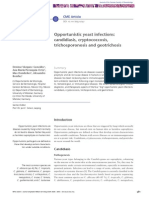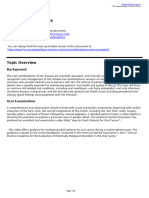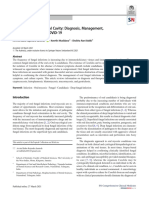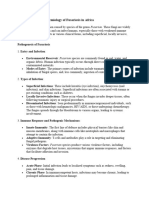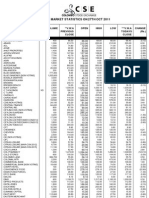0 ratings0% found this document useful (0 votes)
53 viewsAcute Pseudomembranous Candidosis (Thrush)
Acute Pseudomembranous Candidosis (Thrush)
Uploaded by
dwiCandidosis is an oral infection caused by Candida that is seen in people with impaired oral health or immunity. It is traditionally classified into four types: acute pseudomembranous candidosis (thrush), acute atrophic candidosis, chronic hyperplastic candidosis, and chronic atrophic candidosis. Acute pseudomembranous candidosis often affects neonates or those using antibiotics or corticosteroids and can develop into a systemic infection in premature neonates. Chronic hyperplastic candidosis typically presents as leukoplakia at the angles of the mouth or on the tongue and has a higher risk of becoming cancerous.
Copyright:
© All Rights Reserved
Available Formats
Download as DOCX, PDF, TXT or read online from Scribd
Acute Pseudomembranous Candidosis (Thrush)
Acute Pseudomembranous Candidosis (Thrush)
Uploaded by
dwi0 ratings0% found this document useful (0 votes)
53 views1 pageCandidosis is an oral infection caused by Candida that is seen in people with impaired oral health or immunity. It is traditionally classified into four types: acute pseudomembranous candidosis (thrush), acute atrophic candidosis, chronic hyperplastic candidosis, and chronic atrophic candidosis. Acute pseudomembranous candidosis often affects neonates or those using antibiotics or corticosteroids and can develop into a systemic infection in premature neonates. Chronic hyperplastic candidosis typically presents as leukoplakia at the angles of the mouth or on the tongue and has a higher risk of becoming cancerous.
Original Description:
text
Original Title
Candidiasis
Copyright
© © All Rights Reserved
Available Formats
DOCX, PDF, TXT or read online from Scribd
Share this document
Did you find this document useful?
Is this content inappropriate?
Candidosis is an oral infection caused by Candida that is seen in people with impaired oral health or immunity. It is traditionally classified into four types: acute pseudomembranous candidosis (thrush), acute atrophic candidosis, chronic hyperplastic candidosis, and chronic atrophic candidosis. Acute pseudomembranous candidosis often affects neonates or those using antibiotics or corticosteroids and can develop into a systemic infection in premature neonates. Chronic hyperplastic candidosis typically presents as leukoplakia at the angles of the mouth or on the tongue and has a higher risk of becoming cancerous.
Copyright:
© All Rights Reserved
Available Formats
Download as DOCX, PDF, TXT or read online from Scribd
Download as docx, pdf, or txt
0 ratings0% found this document useful (0 votes)
53 views1 pageAcute Pseudomembranous Candidosis (Thrush)
Acute Pseudomembranous Candidosis (Thrush)
Uploaded by
dwiCandidosis is an oral infection caused by Candida that is seen in people with impaired oral health or immunity. It is traditionally classified into four types: acute pseudomembranous candidosis (thrush), acute atrophic candidosis, chronic hyperplastic candidosis, and chronic atrophic candidosis. Acute pseudomembranous candidosis often affects neonates or those using antibiotics or corticosteroids and can develop into a systemic infection in premature neonates. Chronic hyperplastic candidosis typically presents as leukoplakia at the angles of the mouth or on the tongue and has a higher risk of becoming cancerous.
Copyright:
© All Rights Reserved
Available Formats
Download as DOCX, PDF, TXT or read online from Scribd
Download as docx, pdf, or txt
You are on page 1of 1
Candidosis is seen orally in people with altered oral ecology (from dental appliances,
hyposalivation, or the local use of immunosuppressants or antimicrobials) and/or impaired
immunity (eg, transplant recipients, persons on immunosuppressive treatments, persons with
HIV/AIDS or oral cancer, various cellular immune defects.
By tradition, the most commonly used classification of oral candidosis divides the infection into 4
types including (1) acute pseudomembranous candidosis (thrush), (2) acute atrophic
(erythematous) candidosis, (3) chronic hyperplastic candidosis, and (4) chronic atrophic
(erythematous) candidosis.
Acute pseudomembranous candidosis (thrush)
Thrush may be observed in apparently healthy neonates (who have not yet developed immunity)
or in persons in whom antibiotics, corticosteroids, or hyposalivation disturb the oral microflora. In
premature neonates, systemic candidosis may arise. [12]
Oropharyngeal thrush occasionally complicates the use of corticosteroid inhalers or other topical
preparations. Immune defects, especially HIV infection, immunosuppressive treatment,
leukemias, lymphomas, cancer, and diabetes, may predispose patients to candidal infection.
Erythematous candidosis
Erythematous candidosis may cause a sore red mouth, especially of the tongue, in patients
taking broad-spectrum antimicrobials. It also may be a feature of HIV disease. Median rhomboid
glossitis is a red patch occurring in the middle of the dorsum in the posterior area of the anterior
two thirds of the tongue and especially is observed in smokers and in those with HIV disease.
Chronic hyperplastic candidosis
Chronic hyperplastic candidosis typically presents as a leukoplakia often at the angles of the
mouth or on the tongue, and it has a higher malignant potential than some other leukoplakias.
This is especially the case when associated with autoimmune polyendocrinopathy-candidiasisectodermal dystrophy.[13]
You might also like
- Opportunistic Yeast InfectionDocument14 pagesOpportunistic Yeast Infectionelsa_imamNo ratings yet
- CandidiasisDocument19 pagesCandidiasisTeguh Adi PartamaNo ratings yet
- Oral Candidiasis Causes Types and Treatment PDFDocument12 pagesOral Candidiasis Causes Types and Treatment PDFTiborNo ratings yet
- Oral ManifestationsDocument66 pagesOral ManifestationsMiguel DiazNo ratings yet
- b.8 Oral CandidiasisDocument14 pagesb.8 Oral Candidiasisbryamjbriceno100% (1)
- Otolaryngologic Manifestations of HIV Infection: ReviewsDocument6 pagesOtolaryngologic Manifestations of HIV Infection: ReviewsSo NicNo ratings yet
- Oral Candidiasis - ReviewDocument9 pagesOral Candidiasis - ReviewAdhelia Galuh PrmtsrNo ratings yet
- Typhoid ResearchDocument42 pagesTyphoid Researchhamidhasan6944No ratings yet
- Diagnosis and Treatment of Oral CandidosisDocument7 pagesDiagnosis and Treatment of Oral CandidosisYerly Ramirez MuñozNo ratings yet
- Candidiasis MucosalDocument112 pagesCandidiasis MucosalTara Sefanya KairupanNo ratings yet
- Oropharyngeal Candidiasis: Review of Its Clinical Spectrum and Current TherapiesDocument18 pagesOropharyngeal Candidiasis: Review of Its Clinical Spectrum and Current TherapiesDelbert GradyNo ratings yet
- StrongyloidiasisDocument7 pagesStrongyloidiasisZue Pie (Zashid)No ratings yet
- Jurnal Englis 2 KtiDocument17 pagesJurnal Englis 2 KtigilangNo ratings yet
- Antibiotic Prophylaxis in Pediatric Odontology. An UpdateDocument6 pagesAntibiotic Prophylaxis in Pediatric Odontology. An UpdateJavier Farias VeraNo ratings yet
- Pathophysiology of Oral CandidiasisDocument11 pagesPathophysiology of Oral CandidiasisAldyTriawanNo ratings yet
- Oral Infections and Systemic Disease-An Emerging Problem in MedicineDocument7 pagesOral Infections and Systemic Disease-An Emerging Problem in MedicineJing XueNo ratings yet
- Acute Necrotizing Ulcerative GingivitisDocument5 pagesAcute Necrotizing Ulcerative GingivitisVictor GiraldezNo ratings yet
- Nuñal Group - THYPHOID FEVER DraftDocument5 pagesNuñal Group - THYPHOID FEVER Draftvirgo paigeNo ratings yet
- Candidosis 1Document69 pagesCandidosis 1Urwa NaveedNo ratings yet
- Silk 2014Document16 pagesSilk 2014aaNo ratings yet
- Hand Foot and Mouth Disease by RajDocument10 pagesHand Foot and Mouth Disease by RajedsymbiosisNo ratings yet
- Drug-Induced Oral Candidiasis - A Case ReportDocument4 pagesDrug-Induced Oral Candidiasis - A Case ReportFajarRahmantiyoNo ratings yet
- Background TyphoidDocument21 pagesBackground TyphoidNurmala Rahman LNo ratings yet
- Oral Manifestations of TuberculosisDocument4 pagesOral Manifestations of TuberculosisKandiwapaNo ratings yet
- Fungal Diseases of The Oral MucosaDocument5 pagesFungal Diseases of The Oral MucosaManar AlsoltanNo ratings yet
- Fungal Infections of Oral Cavity: Diagnosis, Management, and Association With COVID-19Document12 pagesFungal Infections of Oral Cavity: Diagnosis, Management, and Association With COVID-19Roxana Guerrero SoteloNo ratings yet
- Diphtheria DiseaseDocument16 pagesDiphtheria DiseaseefeefremNo ratings yet
- Oral Health in America A Report of The Surgeon General (Prosiding)Document4 pagesOral Health in America A Report of The Surgeon General (Prosiding)Zkdlin SpaceNo ratings yet
- 16-9+oropharyngeal CandidiasisDocument45 pages16-9+oropharyngeal CandidiasisشيماءNo ratings yet
- Lecture Parasites in Immunocompromised PatientDocument50 pagesLecture Parasites in Immunocompromised PatientalgutNo ratings yet
- Respiratory Infections - 30.10.2023Document61 pagesRespiratory Infections - 30.10.2023johnnycash5404No ratings yet
- Microbial Diseases - Digestive SystemDocument200 pagesMicrobial Diseases - Digestive SystemNolan Cabral100% (2)
- Atrophic CandidiasisDocument5 pagesAtrophic Candidiasisdup11No ratings yet
- Toxoplasmosis and PregnancyDocument39 pagesToxoplasmosis and PregnancyClaudia NovitayantiNo ratings yet
- Fungal Infections in Immunosuppressed Patients: Luis Enrique Jerez PueblaDocument28 pagesFungal Infections in Immunosuppressed Patients: Luis Enrique Jerez Pueblakj185No ratings yet
- ContempClinDent111-3628383 - 100443 HIVDocument5 pagesContempClinDent111-3628383 - 100443 HIVthomas purbaNo ratings yet
- Lec. 3 Epi. of MeaslesDocument39 pagesLec. 3 Epi. of Measleskale.rebwar2004No ratings yet
- StrongyloidiasisDocument5 pagesStrongyloidiasisMufidah OthmanNo ratings yet
- Montes, 2010Document7 pagesMontes, 2010Dianny VacaNo ratings yet
- Severe Odontogenic InfectionsDocument8 pagesSevere Odontogenic InfectionsmumunooNo ratings yet
- Cabt 10 I 1 P 1Document5 pagesCabt 10 I 1 P 1Hanifah Nailul AmaniaNo ratings yet
- Pedo 1Document6 pagesPedo 1ايمن جمعة احمدNo ratings yet
- Acute Otitis Media in Children Prevention of RecurrenceDocument12 pagesAcute Otitis Media in Children Prevention of RecurrenceYesenia HuertaNo ratings yet
- Aerobic Bacteria Associated With Chronic Suppurative Otitis Media in AngolaDocument10 pagesAerobic Bacteria Associated With Chronic Suppurative Otitis Media in AngolaRawcath DOOMNo ratings yet
- Lecture 7Document3 pagesLecture 7photo copyhemnNo ratings yet
- Pediatric For KidsDocument6 pagesPediatric For KidsOasis LimitedNo ratings yet
- Infection FongiqueDocument14 pagesInfection Fongiqueabidsalma02No ratings yet
- Orofacial Viral Infections An UpdateDocument6 pagesOrofacial Viral Infections An UpdateAli RazaNo ratings yet
- Candidiasis - Red and White Manifestations in The Oral CavityDocument8 pagesCandidiasis - Red and White Manifestations in The Oral CavityFajarRahmantiyoNo ratings yet
- Virals - 1Document6 pagesVirals - 1rajesh kumarNo ratings yet
- Final Honors Bio PaperDocument10 pagesFinal Honors Bio Paperapi-247377745No ratings yet
- Oral CandidasisDocument39 pagesOral CandidasisArmada Eka FredianNo ratings yet
- Added Typhi Lit ReviewDocument4 pagesAdded Typhi Lit ReviewolaworeNo ratings yet
- TyphoidDocument2 pagesTyphoidaedintern01No ratings yet
- Pathogenesis and Epidemiology of Fusariosis in Africa 1Document3 pagesPathogenesis and Epidemiology of Fusariosis in Africa 1alexanderchukwu2002No ratings yet
- Fungal Infections of The LungsDocument163 pagesFungal Infections of The Lungsmeaza rorisaNo ratings yet
- Disease Transmission and Infection PreventionDocument36 pagesDisease Transmission and Infection PreventionanayatNo ratings yet
- Jurnal Akut Otitis EksternaDocument3 pagesJurnal Akut Otitis EksternaNadhira Puspita AyuningtyasNo ratings yet
- Dipiro 8 ParasitDocument12 pagesDipiro 8 ParasitErik Firman RusdiantoNo ratings yet
- Health Advice and Immunizations for TravelersFrom EverandHealth Advice and Immunizations for TravelersNo ratings yet
- IOF Qualeffo41 Questionnaire England 0 0Document7 pagesIOF Qualeffo41 Questionnaire England 0 0dwiNo ratings yet
- Depression Care PathwayDocument267 pagesDepression Care PathwaydwiNo ratings yet
- CDM Antibio1 DosageGuidelines Adults enDocument2 pagesCDM Antibio1 DosageGuidelines Adults endwiNo ratings yet
- A Car and A Bike Are My Means Transportation... Jika Ada and Berarti JamakDocument3 pagesA Car and A Bike Are My Means Transportation... Jika Ada and Berarti JamakdwiNo ratings yet
- CE-700 Working Group Initial Cessna 180Document7 pagesCE-700 Working Group Initial Cessna 180Elmer VillegasNo ratings yet
- Massively Multiplayer Online Role Playing Game (MMORPG)Document14 pagesMassively Multiplayer Online Role Playing Game (MMORPG)Sumardi FnuNo ratings yet
- Graham Priest's Theory of ChangeDocument4 pagesGraham Priest's Theory of ChangeWilliam J GreenbergNo ratings yet
- Match The NumbersDocument1 pageMatch The NumbersЕвгения ХвостенкоNo ratings yet
- Effect of Exfoliation Temperature On Carbon Dioxide Capture of Graphene NanoplatesDocument6 pagesEffect of Exfoliation Temperature On Carbon Dioxide Capture of Graphene NanoplatesJulian De BedoutNo ratings yet
- 2018 - Open - Adrienne Chambon PDFDocument20 pages2018 - Open - Adrienne Chambon PDF金仁皓No ratings yet
- Unit 7. Revision and ConclusionDocument5 pagesUnit 7. Revision and ConclusionAryla AdhiraNo ratings yet
- Price List 1Document4 pagesPrice List 1LBTodayNo ratings yet
- YLP - BrochureDocument15 pagesYLP - Brochureharjas singhNo ratings yet
- Richmond County Property Transfers Sept. 12 - 18Document4 pagesRichmond County Property Transfers Sept. 12 - 18augustapressNo ratings yet
- Indian Psychiatric Society in Association With Medical Wing, R.E.R.FDocument608 pagesIndian Psychiatric Society in Association With Medical Wing, R.E.R.FJerry JacobNo ratings yet
- Weberbloc Fix NDocument2 pagesWeberbloc Fix NCharbel AchkoutyNo ratings yet
- PT Enlish6 Q4 FinalDocument6 pagesPT Enlish6 Q4 Finalmariantriguero1229No ratings yet
- ProfileDocument2 pagesProfileDixit PhuyalNo ratings yet
- Correlation 1 - Trigonometry NotesDocument7 pagesCorrelation 1 - Trigonometry Notesdoni poNo ratings yet
- Concom Proposed Federal Constitution As of 12 JulyDocument126 pagesConcom Proposed Federal Constitution As of 12 JulyVERA FilesNo ratings yet
- Tolentino Vs Secretary of FinanceDocument4 pagesTolentino Vs Secretary of FinanceMarkNo ratings yet
- SYLLABUS - ELECTIVE PAPER PHDDocument3 pagesSYLLABUS - ELECTIVE PAPER PHDRaghavendra PrasadNo ratings yet
- Pain Gate TheoryDocument28 pagesPain Gate Theorysahinuri348No ratings yet
- CS Receive and Store Kitchen Supplies and Food StockDocument8 pagesCS Receive and Store Kitchen Supplies and Food StockabisaptadinataNo ratings yet
- Confidential 3501132: Appen - Person/Object SegmentationDocument16 pagesConfidential 3501132: Appen - Person/Object SegmentationStephen Velasco VillaruzNo ratings yet
- Organised Crime in IndiaDocument5 pagesOrganised Crime in Indiarahul singhNo ratings yet
- Second Division: Republic of The Philippines Court of Tax Appeals Quezon CityDocument11 pagesSecond Division: Republic of The Philippines Court of Tax Appeals Quezon CityDennise TalanNo ratings yet
- The History of Discovery, Synthesis and Development of Testosterone For Clinical UseDocument12 pagesThe History of Discovery, Synthesis and Development of Testosterone For Clinical UseQuinn CRNo ratings yet
- PSSG Lina A Rentazida: (RMFB8)Document37 pagesPSSG Lina A Rentazida: (RMFB8)lina rentazidaNo ratings yet
- WP Winning at Home Delivery 1Document12 pagesWP Winning at Home Delivery 1kshemaNo ratings yet
- TE-Road User and Vehicle CharacteristicDocument7 pagesTE-Road User and Vehicle CharacteristicVaibhav PatelNo ratings yet
- New Trend Maths ChapterDocument32 pagesNew Trend Maths ChapterAaron MokNo ratings yet
- Metropolitan Bank and Trust Company Vs Ba FinanceDocument1 pageMetropolitan Bank and Trust Company Vs Ba FinanceJENNY BUTACANNo ratings yet
- 05 Eagle Ridge V CameronDocument1 page05 Eagle Ridge V CameronBasil MaguigadNo ratings yet
